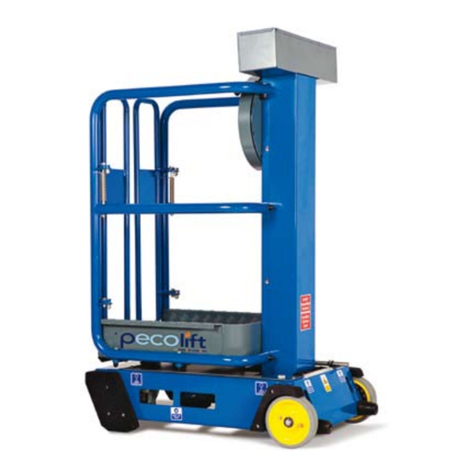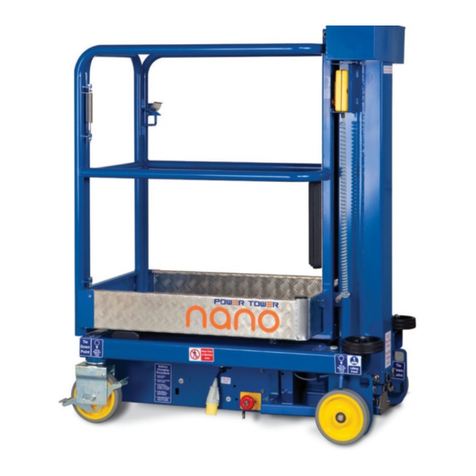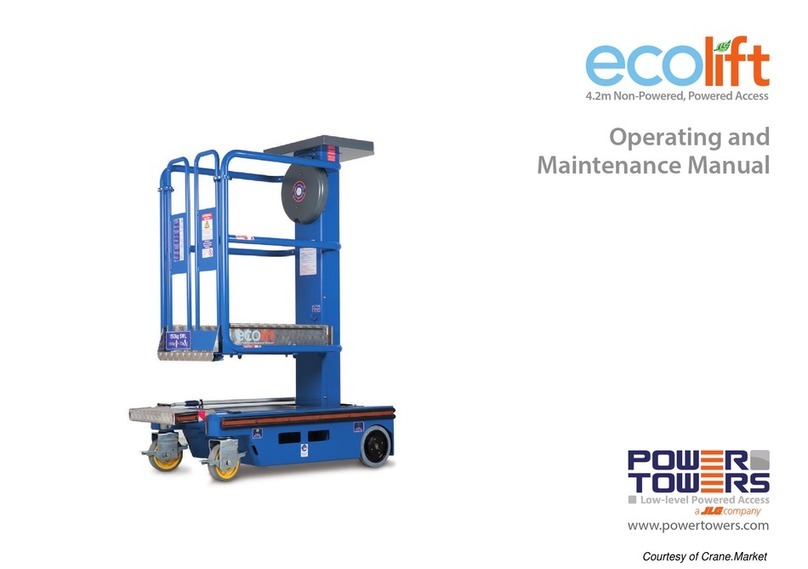SIX MONTHLY CHECKS - LOLER
1. In order to inspect the internal mechanisms of the machine the
following covers must be removed; tool tray (Pic A), mast cap plate
(Pic B, shows mast cap after tool tray is removed) and handle cover
(Pic C). Remove the tool tray using a 5mm allen key, then remove
the mast cap plate using a 6mm allen key. The mast cap screws
(Pic B, arrowed) are additionally secured with a threadlock
adhesive. If diculty is experienced removing these screws then
they will need to be heated with a heat gun for a few minutes.
Remove the handle cover using a special 5mm allen key, which
can be obtained from the manufacturer or his agent.
2. Inspect and lubricate gearwheels. Use Omega 73 no. 2 harsh
environment grease or equivalent. Do not use standard gear
grease because it will dry out prematurely and will lead to
premature gear wear.
3. Elevate the platform approximately 20mm so the back of the
belt clamp bracket and the two countersunk xing screws are
visible. Looking through the inspection hole (Pic D, boxed), check
the two screws are secure. Look inside the mast section from the
top to the rear of the clamp (Pic E), and ensure the two nuts are
secure.
Raise and lower the platform fully and inspect the drive belt
whilst doing so with the aid of a suitable light. Ensure the belt
remains on the top pulley (Pic F, arrowed), bottom pulley
(Pic G, arrowed) and drive cog. If it is found dicult to view the
lower pulley it may be necessary to look through the gap above the
mast roller (Pic H, circled). To do so remove the mast roller cover,
located underneath the platform, by slackening the two M12 nuts
and pulling the cover o (Pic I, shows cover removed and lower
pulley, arrowed).
Minor scung and wear of the belt surfaces, and visible steel
braided wires, is acceptable. However, there must be no signs of
wear or fraying of the steel braided wires. If the steel braided wires
are worn or frayed, please contact the manufacturer.
Inspect the belt retaining plate (Pic J, arrowed). Ensure that the belt
retaining plate does not move when the mast is raised and lowered.
When the internal inspection is complete, ret the mast cap plate
and ret screws with medium strength threadlock. Paint seal the
screws. Ret the handle cover and ret screws with medium
strength threadlock. Paint seal the screws. Ret the tool tray. It is
extremely important that all of these screws are replaced correctly.
4. Check the mast interlock is undamaged and is working correctly.
Check the casing for signs of damage and remove the end plate
(Pic K, arrowed). Insert a large at screwdriver (300mm long
approx.) between the stop screw and the lower pulley block
(Pic L, arrowed) and lever downwards by applying a force of no
more than 10kg. Care must be taken as applying too much force
will damage the stop screw. When moving the block, watch the end
of the interlock bolt (Pic M, arrowed) and ensure it moves inward
and outward as the block is moved down and up. Ret cover and
screw. Paint seal screw when retted.
5. Inspect condition of automatic wheel lock. Look under brush
strip at rear of chassis when platform is elevated so that mast outer
is clear of chassis. Check brake cam plates (Pic N and Fig A, page12)
are undamaged and that the two attaching screws are tight. With
an assistant to lower the platform, observe the action of the cams
and the movement of the brake pins. Ensure the movement is free
and the pins clear the wheel discs. When the platform is elevated
ensure the pins fully engage the brake discs. Ensure the pockets in
the wheels are in good condition.
MAINTENANCE PROCEDURES
10
































